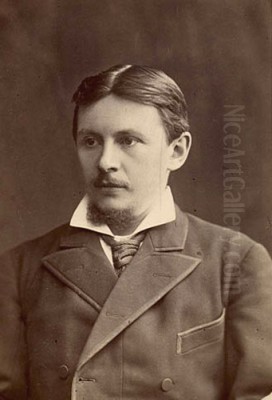
Yuliy Yulevich Klever, also known by his Germanized name Julius von Klever, stands as a significant figure in the landscape of 19th and early 20th-century Russian art. Born into an era of burgeoning national identity and artistic exploration, Klever carved a distinct niche for himself, becoming renowned for his evocative and often dramatic depictions of the Russian wilderness, particularly his mastery of winter scenes and sunsets. While perhaps not always aligned with the dominant socio-political currents of the Peredvizhniki (Wanderers) movement, Klever achieved immense popularity both domestically and internationally, his works admired for their technical skill, atmospheric depth, and accessible beauty. This article delves into the life, artistic journey, and enduring legacy of this prolific painter.
Early Life and Baltic Roots
Yuliy Klever was born on January 31, 1850, in Dorpat, located in the Governorate of Livonia of the Russian Empire, known today as Tartu, Estonia. This Baltic German background would subtly inform his perspective throughout his life. His family environment was one of intellectual pursuit; his father was a chemist, and his mother a doctor, providing a foundation that valued education and likely encouraged disciplined observation. The young Klever showed an early inclination towards art.
His formal schooling included a year at the Dorpat Gymnasium, a period during which his artistic talents were recognized and nurtured by his drawing teacher, Konstantin von Kügelgen. Kügelgen himself hailed from a family of artists and provided crucial early encouragement, likely instilling in Klever a respect for academic tradition combined with a focus on the natural world. This initial guidance set the stage for Klever's future path, steering him towards a career where his innate abilities could flourish. The scenic surroundings of the Baltic region may also have played a role in shaping his early visual sensibilities.
Training at the Imperial Academy of Arts
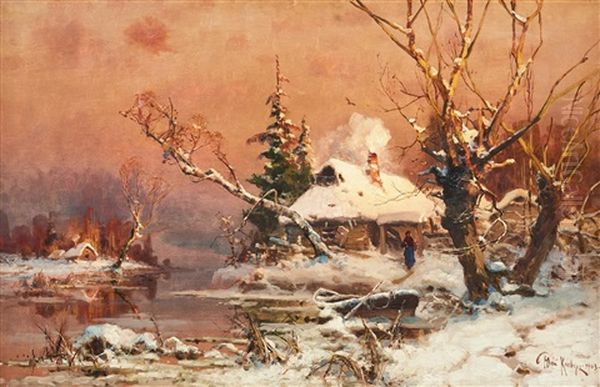
Seeking advanced artistic training, Klever moved to the heart of the Russian Empire, St. Petersburg, and enrolled in the prestigious Imperial Academy of Arts. Initially, perhaps following a more conventional or practical path, he entered the architecture department. However, his true passion lay elsewhere. His innate talent for capturing the nuances of the natural world soon led him to transfer to the landscape painting class.
At the Academy, he studied under notable landscape painters of the time, including Sokrat Vorobiev and possibly Mikhail Clodt, artists who represented the established academic approach to landscape painting. Although sources indicate that Klever did not formally complete the full course of study or graduate in the traditional sense, his talent was undeniable and quickly gained attention. Even during his student years, his sketches, such as those titled "From Dorpat" and "From Tsarskoye Selo," demonstrated a keen eye for detail and composition. His ability was recognized within the Academy circles, marking him as a promising artist despite his unconventional academic trajectory.
Rise to Prominence and Imperial Favor
Klever did not wait for formal graduation to make his mark. He began exhibiting his works as early as 1871. His paintings quickly found favour among collectors and influential figures. An early work, reportedly titled "Sunset," was acquired by Count Pavel Stroganov (though some sources mention a Count Pugachev, Stroganov seems more likely in art patronage circles). This initial success was a significant boost for the young artist.
His reputation continued to grow rapidly. In 1874, another significant painting, possibly also a sunset scene which became one of his signature motifs, was purchased by Grand Duke Nicholas Mikhailovich, a member of the Imperial family known for his historical interests. Such high-level patronage was invaluable. Klever's ability to create visually appealing and technically accomplished landscapes resonated with the tastes of the aristocracy and the burgeoning middle class. His breakthrough came definitively in 1878 when Tsar Alexander II acquired one of his paintings, "A Birch Forest." This Imperial endorsement solidified his status. Further recognition followed in 1881 when Tsar Alexander III, a significant patron of Russian national art, conferred upon him the prestigious title of "Artist of the First Degree" and later appointed him as a professor at the Imperial Academy of Arts, a remarkable achievement for someone who hadn't formally graduated.
Artistic Style: Naturalism, Romance, and the Salon
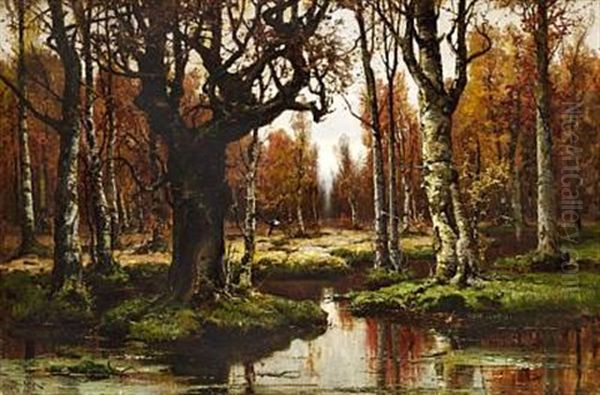
Klever's style is often characterized as a form of academic realism or naturalism, deeply rooted in careful observation of nature. He possessed a remarkable ability to render details – the texture of snow, the intricate branches of trees, the play of light on water and clouds. His works often feature dramatic lighting effects, particularly sunsets and sunrises, which imbue the scenes with a romantic, sometimes theatrical, quality. This combination of detailed realism and atmospheric drama proved highly appealing to the public and critics associated with the Salon taste.
While contemporary landscape painters like the Peredvizhniki Ivan Shishkin focused on an almost scientific rendering of forest interiors, striving for an epic portrayal of Russian nature, Klever's approach often felt more picturesque and composed. Compared to the profound "mood landscapes" of Isaac Levitan, which explored the emotional resonance of the Russian countryside, Klever's works were generally less focused on conveying deep melancholy or specific social commentary, leaning instead towards capturing the inherent beauty and sometimes the starkness of the natural world. His winter landscapes, for which he is perhaps best known, masterfully convey the crisp air, the deep snowdrifts, and the unique light of the season.
His technique involved precise brushwork, often with a smooth finish typical of academic painting, though some works show more textural variation. His color palette could range from subtle and harmonious tones in quieter scenes to vibrant, almost fiery hues in his dramatic sunsets. He was particularly adept at capturing the effects of light filtering through trees or reflecting off snow and ice. This technical facility, combined with his choice of appealing subjects, made his work highly sought after. Some critics noted an elegance, occasionally hinting at a "medieval" feel, perhaps stemming from his precise rendering and compositional choices.
Signature Themes and Representative Works
Throughout his long career, Klever remained devoted to landscape painting. His most recurrent and celebrated theme was the Russian winter. Works simply titled Winter Landscape appear frequently in his oeuvre, showcasing snow-laden forests, frozen rivers, and isolated cabins under vast skies. These paintings capture the stillness and beauty of the winter season, often enhanced by the warm glow of a setting or rising sun, as seen in pieces like Winter Sunset.
Forest scenes were another staple, demonstrating his skill in depicting the complex structures of trees and the interplay of light and shadow within the woods, exemplified by works titled Forest. He also painted scenes reflecting rural life and the relationship between humanity and nature, such as In the Field, which might depict expansive agricultural landscapes under changing skies.
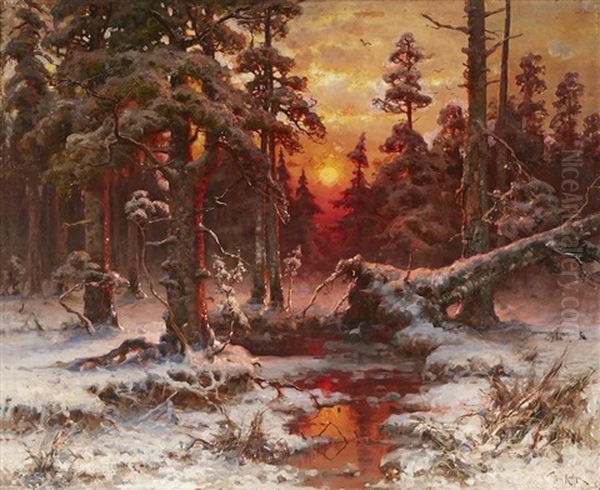
His series featuring dawn scenes, like At Dawn: The Haystack and At Dawn: The Fishing Village, highlight his mastery of light, capturing the specific atmosphere and colors of the early morning hours. Another notable work, Carriage and Sleigh Driver on a Winter Road (c. 1915-1917), combines his skill in rendering winter landscapes with narrative elements. The painting Winter Landscape (1890), which fetched a significant price at auction ($23,000, as noted in the provided information), attests to the enduring market appeal of his classic winter scenes. These representative works showcase his consistent focus on the Russian landscape, his technical prowess, and his ability to evoke atmosphere and mood.
Klever and the Russian Art Scene
Klever operated during a vibrant period in Russian art history, largely dominated by the Peredvizhniki (The Wanderers or The Itinerants). This group, which included major figures like Ivan Kramskoi, Ilya Repin, Vasily Surikov, Vasily Polenov, and the landscape masters Ivan Shishkin and Isaac Levitan, aimed to break away from the strictures of the Academy, bring art to the provinces, and depict Russian life and history with greater realism and social awareness.
While Klever shared the Peredvizhniki's interest in the native Russian landscape, pioneered by earlier artists like Alexei Savrasov (famous for The Rooks Have Arrived), his path diverged. He remained more closely associated with the Imperial Academy, eventually becoming a professor there. His style, often more polished and picturesque, catered more to the tastes of the established Salon system and its patrons, rather than the sometimes gritty realism or social critique found in some Peredvizhniki works. He can be seen alongside artists like Arkhip Kuindzhi, who, while sometimes exhibiting with the Wanderers, was also known for his dramatic, almost theatrical light effects, or Fyodor Vasilyev, a tragically short-lived but brilliant landscape talent. Klever's success demonstrates that alongside the influential Peredvizhniki movement, there was a strong market and appreciation for academically refined, aesthetically pleasing landscapes. He represented a successful, albeit different, trajectory within the rich tapestry of late 19th-century Russian art, a scene that would later see the rise of Impressionist influences with artists like Valentin Serov and Konstantin Korovin.
International Recognition and Influence
Klever's appeal was not confined to Russia. His works gained considerable popularity in Europe, particularly in Germany and France. He became, as described in the provided text, a "darling of the salons" in these countries. His participation in international exhibitions, starting with his first show in Paris in 1880, brought his name to a wider audience. The combination of exotic Russian subject matter rendered with accessible, high-quality technique likely contributed to his success abroad.
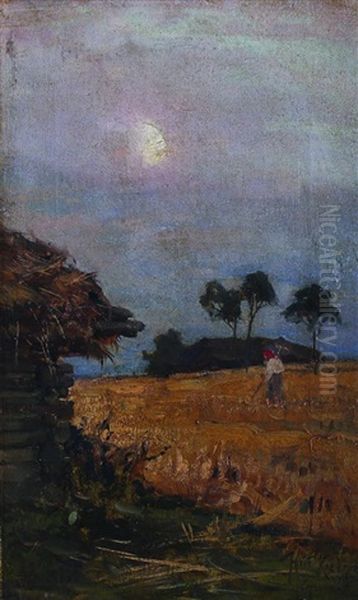
His paintings entered numerous European collections, both private and public. This international acclaim further cemented his reputation and likely contributed to the high demand for his work. While he may not have directly influenced major European art movements, his success demonstrates the international reach and appreciation for Russian landscape painting during this period. His ability to translate the specific character of the Russian landscape into a visual language understood and admired in Western Europe speaks to his skill and the universal appeal of his chosen themes.
Academic Role, Workshop, and Later Career
His appointment as a professor at the Imperial Academy of Arts in 1878 was a significant milestone. It placed him in a position of influence, teaching landscape painting to a new generation of artists. He headed the landscape painting studio, guiding students in the techniques and aesthetics he championed. This academic role solidified his position within the official art establishment of Russia.
Like many highly successful and prolific artists of his time, Klever is known to have maintained a busy studio, likely employing assistants or students to help meet the high demand for his paintings. This practice involved creating variations of popular compositions or even direct copies under his supervision. While common, this inevitably leads to questions of attribution for some works associated with his name and contributes to the large volume of paintings credited to him found in collections and on the art market today. Disentangling the master's hand from that of his workshop remains a challenge for art historians and connoisseurs.
His later career was marked by continued activity, but also reportedly by some difficulties. Around the turn of the century, there are accounts of a scandal involving alleged misuse of funds or impropriety related to his academic position, which led to his temporary departure from Russia. He spent some time in Germany before eventually returning to St. Petersburg (later Petrograd, then Leningrad). Despite these potential setbacks, he continued to paint, although perhaps with less prominence than in his peak years.
Final Years and Enduring Legacy
Yuliy Klever lived through a period of immense upheaval in Russia, witnessing the fall of the Tsarist regime, the Revolution of 1917, and the early years of the Soviet Union. He passed away in Leningrad (St. Petersburg) in 1924, at the age of 74. By this time, the art world had been radically transformed by avant-garde movements like Suprematism and Constructivism, spearheaded by artists such as Kazimir Malevich, making Klever's style appear distinctly traditional.
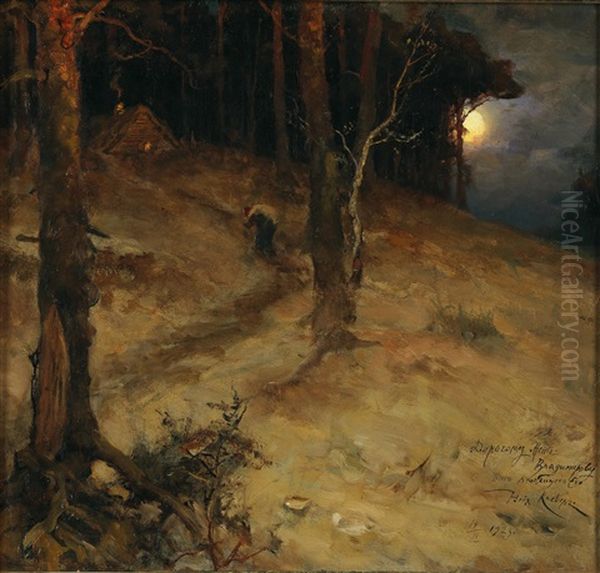
Nevertheless, Klever's legacy endured. His paintings, particularly the winter landscapes and dramatic sunsets, remained popular with the public and collectors. His work continues to be sought after in the Russian and European art markets, often commanding high prices at auction. His contribution lies in his prolific output, his technical mastery within the academic landscape tradition, and his ability to capture the picturesque beauty of the Russian natural world in a way that resonated deeply with his contemporaries and continues to find appreciation today.
He stands as a testament to the diversity of Russian art in the late 19th century, representing a successful alternative to the dominant Peredvizhniki ideology. While perhaps not an innovator in the modernist sense, Yuliy Klever was a master craftsman who skillfully depicted the landscapes he loved, leaving behind a vast body of work that celebrates the beauty, majesty, and sometimes the starkness of the Russian environment. His paintings remain a window into a specific aesthetic sensibility and a particular vision of Russia's natural heritage.